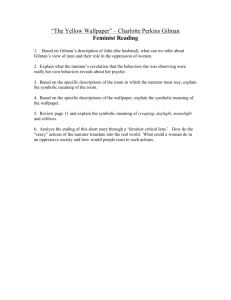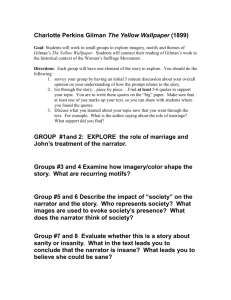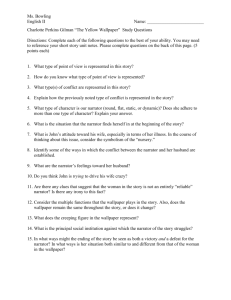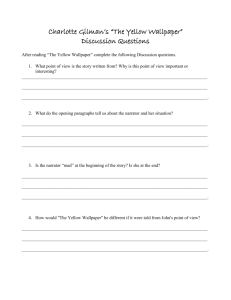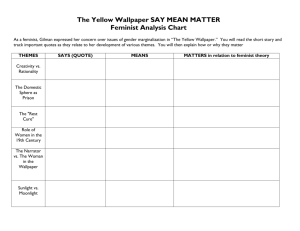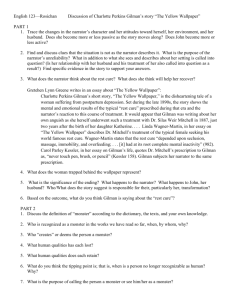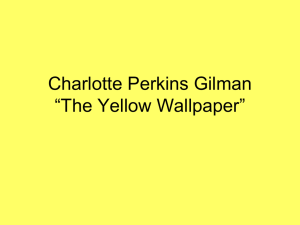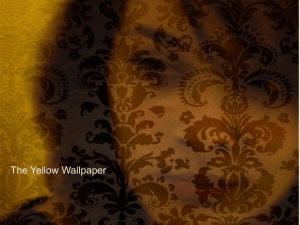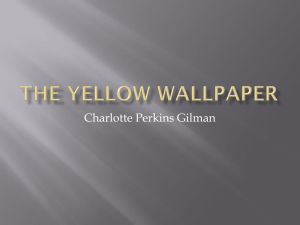first draft of my literary analysis
advertisement
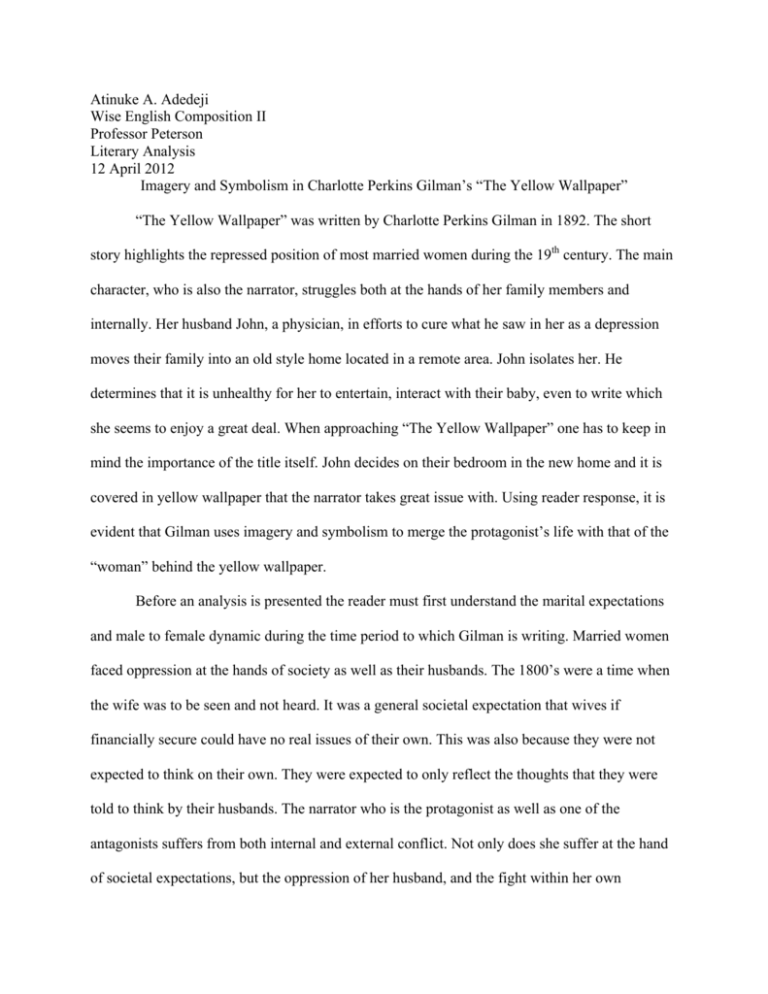
Atinuke A. Adedeji Wise English Composition II Professor Peterson Literary Analysis 12 April 2012 Imagery and Symbolism in Charlotte Perkins Gilman’s “The Yellow Wallpaper” “The Yellow Wallpaper” was written by Charlotte Perkins Gilman in 1892. The short story highlights the repressed position of most married women during the 19th century. The main character, who is also the narrator, struggles both at the hands of her family members and internally. Her husband John, a physician, in efforts to cure what he saw in her as a depression moves their family into an old style home located in a remote area. John isolates her. He determines that it is unhealthy for her to entertain, interact with their baby, even to write which she seems to enjoy a great deal. When approaching “The Yellow Wallpaper” one has to keep in mind the importance of the title itself. John decides on their bedroom in the new home and it is covered in yellow wallpaper that the narrator takes great issue with. Using reader response, it is evident that Gilman uses imagery and symbolism to merge the protagonist’s life with that of the “woman” behind the yellow wallpaper. Before an analysis is presented the reader must first understand the marital expectations and male to female dynamic during the time period to which Gilman is writing. Married women faced oppression at the hands of society as well as their husbands. The 1800’s were a time when the wife was to be seen and not heard. It was a general societal expectation that wives if financially secure could have no real issues of their own. This was also because they were not expected to think on their own. They were expected to only reflect the thoughts that they were told to think by their husbands. The narrator who is the protagonist as well as one of the antagonists suffers from both internal and external conflict. Not only does she suffer at the hand of societal expectations, but the oppression of her husband, and the fight within her own consciousness. The narrator was convinced by John that there was nothing wrong with her and she would be well, actually that she already was better. She put on a front in for her husband which is noticeable during their conversation on improvement in her eating habits, “…my appetite may be better in the evening when you are here, but it is worse in the morning when you are away”(Gilman 3). This quote from the story shows that the narrator suppresses her unhealthy habits as not to upset her husband. She states at several points that she simply puts on a show for her husband, not wanting to disappoint him at all. That was the expectation of the obedient wife during this time period. So the narrator attempts and fails to maintain herself and allows her mind to play tricks on her that finally takes her over. Gilman uses imagery in the story to relate the yellow wallpaper to the life of the narrator. Gilman is able to use the description of the wallpaper to suggest the mood and mind state of the narrator. Each time she discusses a change in direction the reader can relate that back to the sharp changes in the writing and mind of the narrator. The narrator states that the lines of wallpaper will at certain points “plunge off at outrageous angles” (Gilman 1). This quote creates a word picture of chaos as the reader can compare that the reader can compare to the chaotic direction in the mind of the narrator. When she speaks of her husband or sarcastically harps on just how caring he is she jumps back to the wallpaper. As if thinking about or writing about her husband triggers thoughts of the yellow wallpaper and its obstructive pattern and the woman trapped behind it. The breaks in her stream of consciousness match the breaks that she hates so much in the wallpaper. Not only is the design of the wallpaper reflective of the narrator’s consciousness but the color as well. Gilman did not choose the color yellow haphazardly. This choice in color by the author can be seen as a sign of the frailty in the narrator as she was too introverted to speak up for herself and stand firmly against her husband. The narrator herself speaks of the color of the paper with contempt. She said, “The color is repellent, almost revolting; a smoldering unclean yellow” (Gilman 1). Yellow, the color of the paper, represents in some respects cowardice. Her comments on just how disastrous the wallpaper is reflect the same disorder in her thoughts. This is the internal conflict within the short story. The narrator suffers a mental breakdown which is prolonged by the denial of her husband, John who attempts to tell her exactly what it is that she is feeling. The narrator’s pent up and repressed energies and thoughts found the wallpaper as an outlet. She obsessed over it until finally it consumed her. She and the woman behind the wallpaper became one and the same not only symbolically but actually in the mind of the narrator. The physical aspects of the wallpaper were not the only symbol used by Gilman. She also uses the narrator’s crazed obsession with the wallpaper as a symbol for the trapped life of the narrator. The narrator spends countless days studying the wallpaper she says that “[y]ou think you have mastered it, but just as you get well underway in following, it turns a back somersault and there you are” (Gilman 4). She obsesses over every detail, every stain, and then decides that there is a woman trapped behind the wallpaper. She believes that the wallpaper troubles her because the woman behind it shakes at it, almost challenging the confines of it. Much like the narrator does when she refuses her husband’s demands of her like writing although he’s asked her not to. She even says that “[s]ometimes I think there is a great many woman behind…” (Gilman 7). Gilman shows the reader that the narrator sensed that she was not alone in her struggles. That there was a great many women trapped behind the wallpaper. This is then a symbolic wallpaper that cloaked and repressed the will of woman through marriage in the 19th century. Gilman does an excellent job using the yellow wallpaper as a symbol for the life of the story’s narrator. The short story highlights a serious issue in the life of married women in the 1800’s. There is a certain sympathy evoked in the reader for the narrator through the parallel created by the author. The narrator spends most of her time alone or being analyzed by people who do not include her own opinion in their evaluation of her state. The story is told through a first person point of view as well as a stream of conscious that causes imagery that makes the reader feel as if they are actually in the room with the narrator. There is an obvious change in tone and in thoughts and focus of the narrative much like the noted change she sees in the wallpaper. Gilman’s use of imagery and the style and formatting of her writing only enhance the obvious similarities between the woman trapped behind the wall paper and the narrator herself. The human psyche easily relates to text that creates a parallel between something more interpretive and something visual. Imagery is important to a reader’s comprehension of an idea or concept in text. The interpretive part being the repression and mental instability faced by the narrative, and the visual aid that the wallpaper stands as since you can literally picture the color and chaos in your mind as you read the work. Works Cited Perkins Gilman, Charlotte. “The Yellow Wallpaper.” Etext.virginia.edu. University of Virginia Library. 2005. Web. 1 May 2012.
